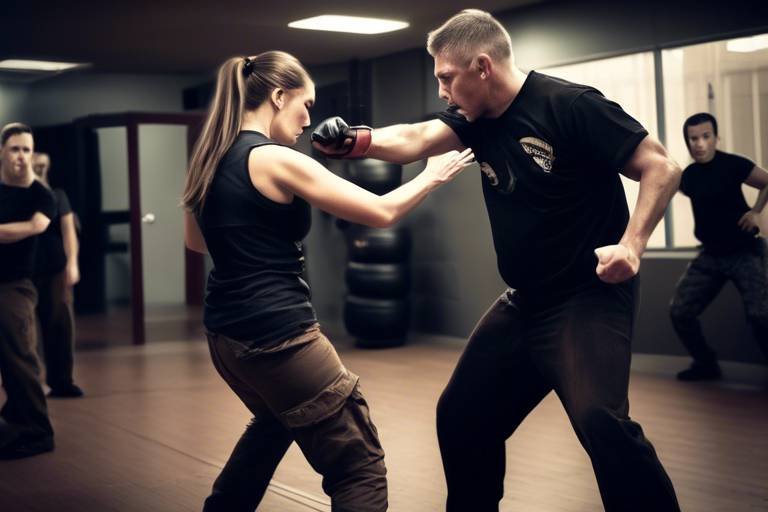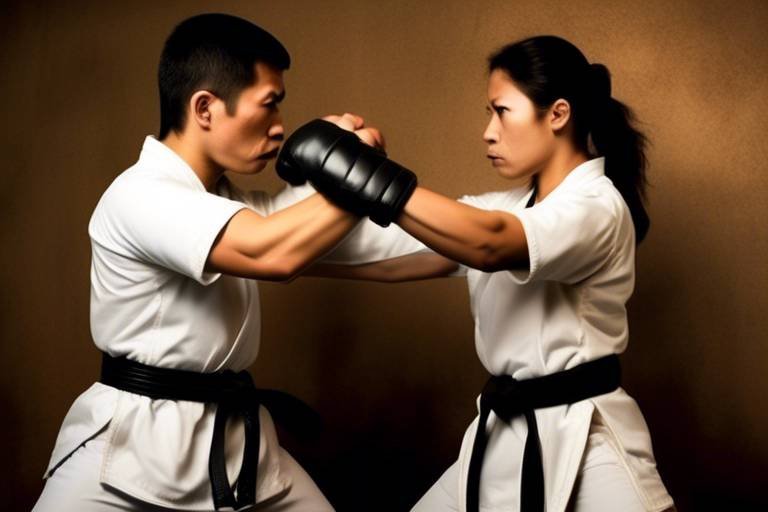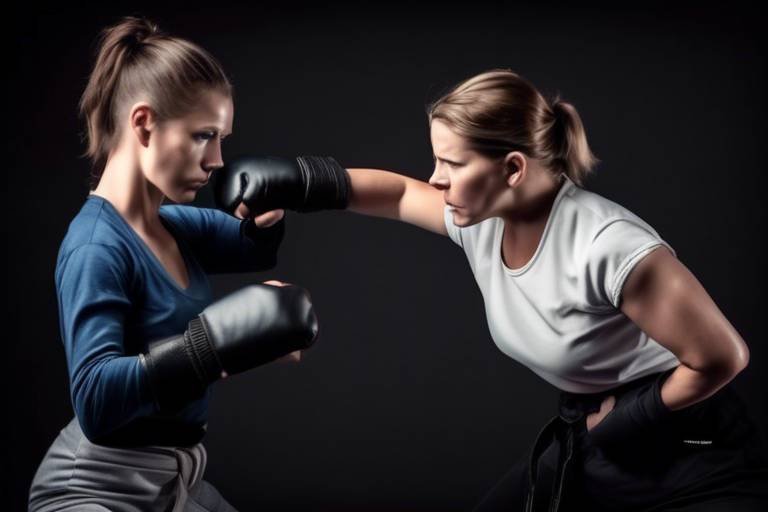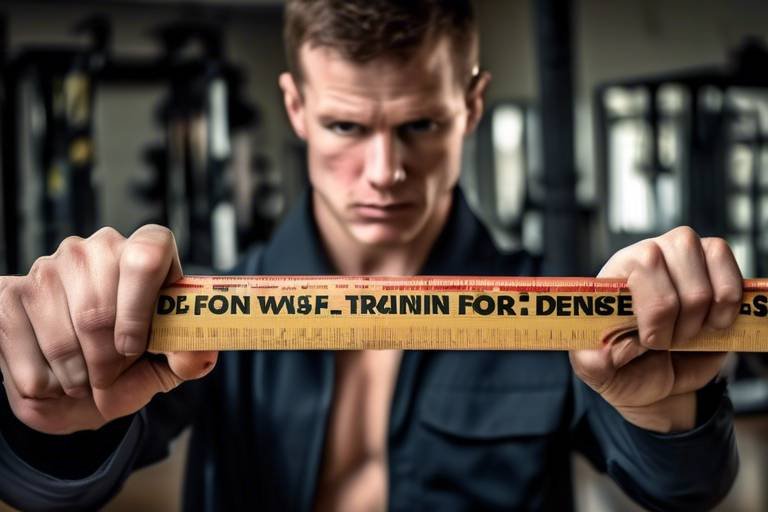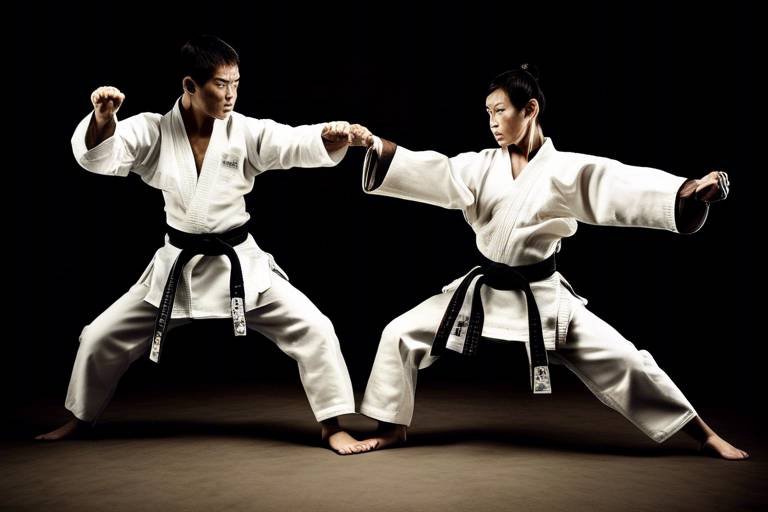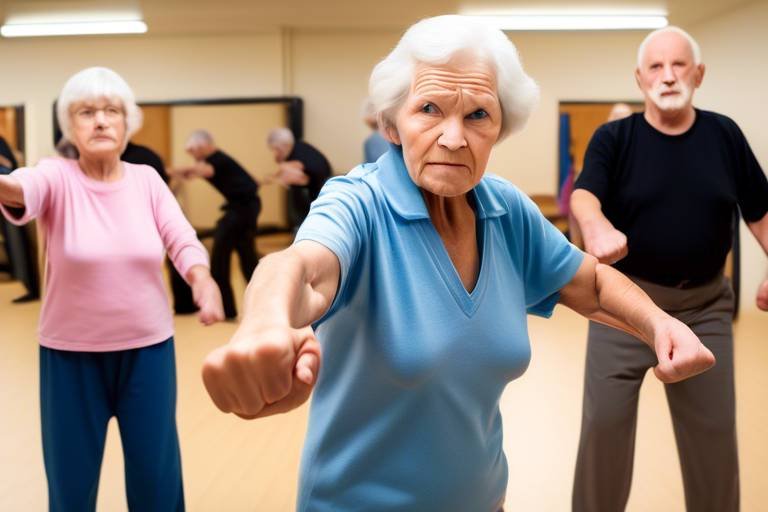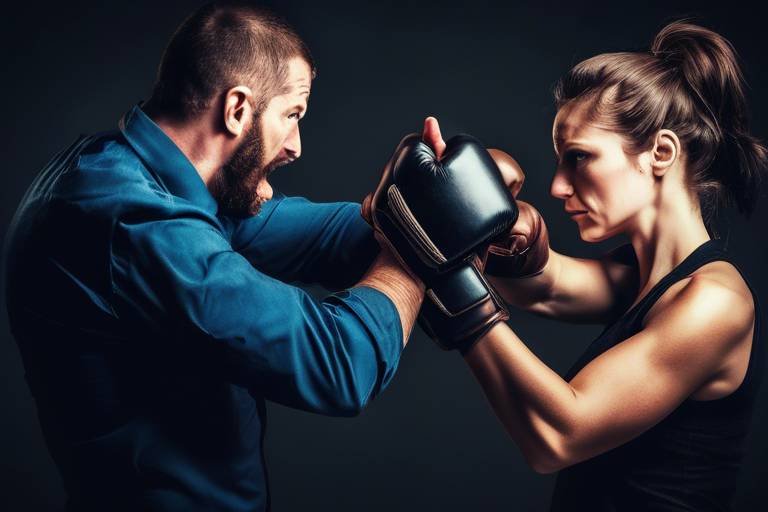Self-Defense Training - Preparing for the Unexpected
In a world where uncertainty looms around every corner, the importance of self-defense training cannot be overstated. Imagine walking down the street, lost in thought, when suddenly you sense someone is following you. What do you do? This is where the power of self-defense training comes into play. It's not just about learning how to throw a punch or execute a kick; it's about empowerment, awareness, and preparation for the unexpected. Whether you’re a seasoned martial artist or a complete novice, self-defense training equips you with the skills and mindset to handle potentially dangerous situations with confidence.
Self-defense is a multifaceted concept that goes beyond mere physical techniques. It encompasses a deep understanding of the principles behind protecting oneself, including the legal and moral implications of taking action in a threatening situation. Knowing when and how to defend yourself is crucial, as the consequences of your actions can have lasting effects on your life. By engaging in self-defense training, you not only learn how to protect yourself but also gain insight into the ethical considerations that come with it.
So, what does self-defense training entail? It involves a combination of physical techniques, mental preparedness, and situational awareness. As we dive deeper into this topic, you'll discover various training methods that can help you feel empowered and ready to face unforeseen circumstances. From martial arts to basic self-defense strategies, there's something for everyone. The journey of self-defense training is not just about learning how to fight; it’s about transforming your mindset, enhancing your confidence, and cultivating a sense of security in your everyday life.
Moreover, self-defense training can be a fun and engaging way to stay fit and meet new people. Imagine stepping into a dojo or training center, surrounded by individuals who share your passion for personal safety and empowerment. You’ll not only learn valuable skills but also build lasting friendships along the way. It's an opportunity to challenge yourself, push your limits, and grow both physically and mentally.
In the upcoming sections, we will explore the various types of self-defense techniques available, the importance of mental preparedness, and how to find the right self-defense class for your needs. By the end of this article, you will have a comprehensive understanding of what it takes to be prepared for the unexpected and how self-defense training can be a transformative experience in your life.
- What is self-defense training? Self-defense training involves learning techniques and strategies to protect oneself from physical harm, focusing on both physical skills and mental preparedness.
- Do I need to be fit to start self-defense training? No, self-defense training is suitable for individuals of all fitness levels. Many classes cater to beginners and focus on building strength and skills over time.
- How long does it take to become proficient in self-defense? Proficiency varies by individual and training frequency, but consistent practice over several months can lead to significant improvements in skill and confidence.
- Can self-defense training help with confidence? Absolutely! Self-defense training not only teaches you physical techniques but also helps build mental resilience and confidence in your ability to handle unexpected situations.

Understanding Self-Defense
Self-defense is often misunderstood as merely a set of physical techniques designed to fend off an attacker. However, the essence of self-defense goes much deeper. It’s about awareness, preparedness, and the ability to make quick decisions in high-pressure situations. Understanding self-defense involves grasping the legal and moral implications of defending oneself. For instance, did you know that the laws regarding self-defense can vary significantly from one place to another? In some jurisdictions, you might be required to retreat from a confrontation if it is safe to do so, while in others, you have the right to stand your ground. This knowledge is crucial, as it can influence how you react when faced with a threat.
Moreover, self-defense is not just a physical battle; it also encompasses psychological aspects. The mental component of self-defense is about cultivating a mindset that allows you to react effectively when danger arises. This involves understanding your own strengths and weaknesses, as well as the dynamics of a potential confrontation. For example, a confident individual is less likely to be targeted by an aggressor. Confidence can act as a shield, making you appear less vulnerable. Hence, self-defense is as much about mental fortitude as it is about physical prowess.
In addition to the legal and mental aspects, it’s essential to recognize that self-defense techniques can be tailored to fit various situations. Whether you’re in a crowded subway or a quiet street, the ability to assess your surroundings and react accordingly can be the difference between safety and danger. This is where situational awareness comes into play. By honing your ability to observe your environment, you can identify potential threats before they escalate into dangerous situations.
To better understand the principles of self-defense, let’s take a look at some key elements:
| Element | Description |
|---|---|
| Legal Aspects | Understanding the laws regarding self-defense in your area. |
| Moral Implications | Reflecting on the ethics of using force to protect oneself. |
| Situational Awareness | Being alert to your surroundings and potential threats. |
| Mental Preparedness | Developing the mindset to respond effectively under pressure. |
In summary, understanding self-defense transcends physical techniques; it’s a multifaceted approach that includes legal knowledge, mental preparedness, and situational awareness. By embracing these elements, you can empower yourself to not only defend against an attacker but also to navigate life with a greater sense of security and confidence.
- What is self-defense? Self-defense refers to the legal right to use reasonable force to protect oneself from an aggressor.
- Do I need to be physically strong to learn self-defense? No, self-defense techniques often rely on strategy and technique rather than brute strength.
- Are there any legal repercussions for using self-defense? Yes, the legality of self-defense can vary by location and situation, so it’s important to understand local laws.
- Can self-defense training help with confidence? Absolutely! Training not only teaches techniques but also builds confidence and awareness.

Types of Self-Defense Techniques
When it comes to self-defense, understanding the various techniques available can be a game changer. It’s not just about throwing punches or kicks; it’s about knowing which method is most effective for different situations. Self-defense techniques can be broadly categorized into several types, each with its own unique approach and application. Whether you’re a complete beginner or someone looking to enhance your skills, there’s something for everyone. Let's dive into some of the most popular and effective self-defense techniques.
Martial Arts are often the first thing that comes to mind when we think about self-defense. They encompass a range of disciplines, each offering its own set of techniques. From the fluid movements of Karate to the ground techniques of Brazilian Jiu-Jitsu, martial arts provide practitioners with the skills to defend themselves effectively. Here’s a quick overview of some popular martial arts:
| Martial Art | Focus | Key Techniques |
|---|---|---|
| Karate | Striking | Punches, Kicks, Blocks |
| Brazilian Jiu-Jitsu | Ground Fighting | Submissions, Leverage Techniques |
| Krav Maga | Real-World Self-Defense | Defensive Tactics, Weapon Defense |
Each of these martial arts has its own philosophy and techniques that can be tailored to individual needs. For example, Krav Maga is known for its practical approach, emphasizing real-world scenarios and efficient techniques that can be learned quickly. This makes it an excellent choice for those looking to gain confidence in their self-defense abilities in a short period of time.
On the other hand, Karate emphasizes discipline and control, teaching practitioners not only how to defend themselves but also how to develop a strong mental focus. The striking techniques learned in Karate can be incredibly effective in a self-defense situation, allowing individuals to create distance between themselves and an aggressor.
Then we have Brazilian Jiu-Jitsu, which focuses on ground fighting and submission techniques. This martial art is particularly empowering for individuals who may not have the physical strength to overpower larger opponents. Through the use of leverage and technique, practitioners can control and submit their opponent, making it a practical choice for self-defense.
In addition to martial arts, there are also basic self-defense strategies that everyone should know, regardless of their physical abilities. These strategies often focus on:
- Escaping from holds or grips
- Using your voice to attract attention
- Targeting vulnerable areas of an attacker
Understanding these basic principles can significantly boost your confidence and preparedness in a potentially dangerous situation. Remember, self-defense is not just about physical techniques; it’s also about awareness and the ability to think quickly under pressure.
In conclusion, the world of self-defense techniques is vast and diverse. Whether you choose to train in martial arts or focus on basic self-defense strategies, the key is to find what works best for you. Each technique offers unique benefits that can empower you to face unexpected situations with confidence and resilience.
Q: Do I need to be physically fit to start self-defense training?
A: Not at all! Self-defense training is designed for individuals of all fitness levels. The focus is on learning techniques that can be adapted to your physical abilities.
Q: How long does it take to become proficient in self-defense?
A: Proficiency varies from person to person, but with regular practice, many individuals start feeling more confident in just a few months.
Q: Are self-defense classes safe?
A: Yes, self-defense classes prioritize safety. Instructors are trained to ensure that all training is conducted in a safe environment while still being effective.

Martial Arts Overview
When it comes to self-defense, martial arts offer a treasure trove of skills and techniques that can empower individuals in a variety of situations. Think of martial arts as a Swiss Army knife for personal safety; each discipline is like a different tool, designed to tackle specific challenges. From striking techniques to grappling and ground fighting, martial arts provide a comprehensive approach to defending oneself. It's not just about throwing punches or performing kicks; it's about understanding your body, learning discipline, and developing a mindset that prepares you for the unexpected.
One of the most appealing aspects of martial arts is its versatility. Whether you're looking for a way to get fit, build confidence, or learn how to protect yourself, there's a style that can cater to your needs. Some popular martial arts include:
- Karate: Known for its powerful strikes and emphasis on discipline.
- Brazilian Jiu-Jitsu: Focuses on ground fighting and submissions, allowing smaller individuals to defend against larger opponents.
- Krav Maga: A practical and effective self-defense system that combines techniques from various martial arts.
Each of these styles brings something unique to the table. For instance, karate teaches not only how to strike but also the importance of mental focus and respect for others. Brazilian Jiu-Jitsu, on the other hand, emphasizes leverage and technique over brute strength, making it an excellent choice for individuals of all sizes. Krav Maga is particularly appealing for those looking for real-world self-defense techniques, as it focuses on practical scenarios rather than sport-based techniques.
Moreover, martial arts training fosters a sense of community. When you step into a dojo or training facility, you're not just there to learn; you're joining a family of like-minded individuals who share your goals. This camaraderie can be incredibly motivating and can help you stay committed to your training. In the world of self-defense, having a support system can make all the difference, especially when you're facing the challenges of learning something new.
In summary, martial arts offer a dynamic and engaging way to prepare for the unexpected. They not only teach you how to defend yourself but also equip you with mental resilience and physical fitness. So, if you’re considering self-defense training, exploring different martial arts styles could be your first step toward empowerment.
Q: Can anyone learn martial arts?
A: Absolutely! Martial arts are designed for individuals of all ages and fitness levels. Many schools offer classes tailored to beginners to help you get started.
Q: How long does it take to become proficient in martial arts?
A: Proficiency varies depending on the individual and the style of martial arts. Generally, consistent practice over several months can lead to noticeable improvements.
Q: Do I need special gear to start training?
A: While some martial arts require specific uniforms or gear, many classes allow beginners to start with comfortable athletic wear until they decide to commit.
Q: Is martial arts training safe?
A: Like any physical activity, there are risks involved, but proper training and safety protocols significantly reduce the likelihood of injury. Always choose a reputable instructor.

Karate
Karate, a striking martial art originating from Japan, is not just about throwing punches and kicks; it's a comprehensive discipline that combines physical prowess with mental fortitude. When you step onto the dojo floor, you’re not only learning how to defend yourself but also embracing a philosophy that promotes respect, discipline, and self-control. Imagine standing tall, your heart racing as you prepare to engage in a sparring match. Each movement is a dance, a blend of power and precision that can empower you in real-life situations.
One of the most significant advantages of practicing karate is its emphasis on self-discipline. As you train, you learn to control your body and mind, which translates into greater confidence in your everyday life. This mental discipline is crucial when faced with unexpected confrontations. You can think of karate as a mental armor that prepares you to face challenges head-on, whether in the dojo or out in the real world. It teaches you to stay calm under pressure, making split-second decisions that could be the difference between safety and danger.
Moreover, karate techniques are incredibly effective for self-defense. Here are a few key elements that make karate a formidable choice:
- Striking Techniques: Powerful punches and kicks that can incapacitate an attacker.
- Blocking and Parrying: Skills that help you defend against incoming strikes.
- Footwork: Agile movement that allows you to evade attacks and position yourself advantageously.
What’s fascinating about karate is that it’s accessible to everyone, regardless of age or fitness level. Whether you're a child looking to build confidence or an adult seeking to enhance your self-defense skills, karate offers a welcoming environment. Many dojos provide classes tailored to different age groups and skill levels, ensuring that everyone can find their place. As you progress, you’ll earn belts that signify your growth, which serves as a tangible reminder of your dedication and hard work.
In conclusion, karate is more than just a means of physical defense; it’s a way of life. The skills and lessons learned in the dojo extend far beyond the mat, helping individuals navigate life's challenges with grace and confidence. So, whether you're looking to learn self-defense, improve your fitness, or simply find a new hobby, karate could be the perfect fit. It's an art form that empowers you to take control of your life, preparing you for whatever unexpected challenges may come your way.
Here are some common questions people have about karate and its benefits for self-defense:
- Is karate suitable for all ages? Absolutely! Karate classes are available for children, teens, and adults, with programs designed to suit various skill levels.
- Do I need to be fit to start karate? Not at all! Karate is for everyone, and beginners can start at any fitness level. The training will help improve your fitness over time.
- How long does it take to learn karate? Progress varies by individual, but with consistent training, you can expect to see significant improvement within a few months.
- Can karate really help me in a self-defense situation? Yes! Karate teaches effective techniques for defending yourself, along with the confidence to use them when necessary.

Brazilian Jiu-Jitsu
When it comes to self-defense, Brazilian Jiu-Jitsu (BJJ) stands out as a powerful method that emphasizes technique over brute strength. Imagine being able to control a larger opponent simply by using leverage and skill—this is the essence of BJJ. It’s like David vs. Goliath, where the smaller, more agile individual can outmaneuver a bigger adversary. BJJ is particularly effective in real-life situations, especially when a confrontation goes to the ground, which is often the case in street fights.
One of the most appealing aspects of Brazilian Jiu-Jitsu is its focus on ground fighting. Practitioners learn a variety of techniques that include joint locks, chokes, and positional control. By mastering these techniques, individuals can effectively neutralize threats without relying solely on strength. This makes BJJ accessible to people of all sizes and abilities. In fact, many women and smaller individuals find BJJ to be an empowering way to defend themselves.
Moreover, BJJ training fosters a sense of community and camaraderie among practitioners. The environment in a BJJ class is typically supportive, where students encourage each other to improve and learn together. This not only helps in building physical skills but also enhances mental resilience. In grappling with partners during practice, students learn to stay calm under pressure—an essential skill in any self-defense situation.
To give you a clearer picture of what Brazilian Jiu-Jitsu offers, here are some key benefits:
- Self-Defense Skills: BJJ equips you with practical skills that can be used in real-life situations.
- Physical Fitness: The training is a great workout, improving your strength, flexibility, and endurance.
- Mental Toughness: Overcoming challenges on the mat translates to increased confidence in daily life.
- Community: Joining a BJJ school connects you with a network of supportive individuals.
In summary, Brazilian Jiu-Jitsu is more than just a martial art; it's a comprehensive self-defense system that empowers individuals through skill, strategy, and community. It's about gaining the ability to protect yourself while also cultivating a mindset that values discipline and respect. So, if you're considering self-defense training, BJJ might just be the perfect fit for you!
Q: Is Brazilian Jiu-Jitsu suitable for beginners?
A: Absolutely! BJJ classes cater to all skill levels, and beginners are welcomed with open arms.
Q: Do I need to be in shape to start BJJ?
A: No, you don’t need to be in peak physical condition. BJJ training will help you improve your fitness over time.
Q: How long does it take to become proficient in BJJ?
A: Proficiency varies by individual, but consistent training can lead to noticeable improvements within a few months.
Q: What should I wear to a BJJ class?
A: Most schools require a gi (a traditional martial arts uniform), but some offer classes in athletic wear.
Q: Is BJJ effective for self-defense?
A: Yes, BJJ is highly effective for self-defense, especially in situations where a confrontation goes to the ground.

Situational Awareness
When it comes to self-defense, is your first line of defense. It’s like having a sixth sense that helps you navigate through life’s unpredictable moments. Imagine walking down a busy street, your mind is buzzing with thoughts about your day, and suddenly, you notice a shady character lurking in the corner. That’s the power of situational awareness—it allows you to spot potential threats before they escalate. But how do you cultivate this essential skill? Let’s break it down.
First and foremost, situational awareness is about being present in your environment. It’s easy to get lost in your phone or daydream while walking, but that’s when you become an easy target. Keep your head up and your eyes scanning your surroundings. Look for anything that seems out of place or individuals who are acting strangely. This doesn’t mean you should live in a constant state of paranoia, but rather develop a habit of observation. Think of it as a game where you’re the detective, piecing together clues about your environment.
Next, consider the three levels of situational awareness:
- Perception: This is where you notice what’s happening around you. Are there people nearby? Is anyone approaching you? Are there any unusual sounds?
- Comprehension: Once you perceive your environment, you need to understand what it means. For instance, if you see someone acting aggressively, what does that imply for your safety?
- Projection: This is the ability to predict what might happen next based on your observations. If someone is approaching you fast, what are your options? Can you escape, or do you need to prepare to defend yourself?
To enhance your situational awareness, practice regularly. You can do this by engaging in activities that require focus, such as martial arts training, or even simple exercises like walking in a park while consciously observing your surroundings. The more you practice, the more natural it will become. You can also try role-playing scenarios with friends, where one person acts as a potential threat, and you practice your responses. This not only sharpens your awareness but also boosts your confidence in handling real-life situations.
Lastly, remember that situational awareness is not just about recognizing danger; it’s also about being aware of the people around you. Are they friendly? Do they seem trustworthy? Building a sense of community can also enhance your safety. When you know your neighbors or the people in your local area, you can better identify when something feels off.
In conclusion, situational awareness is a crucial skill that everyone should develop. It empowers you to take control of your surroundings and make informed decisions. By being observant, understanding your environment, and practicing regularly, you can significantly increase your chances of staying safe in unexpected situations.
Q1: What is situational awareness?
A1: Situational awareness is the ability to be aware of your surroundings and understand potential threats or dangers. It involves perception, comprehension, and projection of what might happen next.
Q2: How can I improve my situational awareness?
A2: You can improve your situational awareness by practicing observation techniques, engaging in activities that require focus, and role-playing potential scenarios with friends or family.
Q3: Is situational awareness only important for self-defense?
A3: While situational awareness is crucial for self-defense, it is also valuable in everyday life for making informed decisions and enhancing personal safety.
Q4: Can situational awareness be learned?
A4: Yes, situational awareness can be learned and improved over time with practice and conscious effort.

Mental Preparedness for Self-Defense
Mental readiness is just as crucial as physical training when it comes to self-defense. Imagine you're walking down the street, and suddenly you sense something is off. Your heart races, your palms sweat, and all of a sudden, you're faced with a choice: freeze or act. This is where mental preparedness comes into play. It’s not just about knowing how to throw a punch or escape a hold; it’s about having the right mindset to handle unexpected situations with confidence and poise.
To cultivate a self-defense mindset, one must focus on a few key strategies. First and foremost is the development of confidence. Confidence doesn’t come overnight; it’s built through practice and experience. When you train regularly, whether in martial arts or self-defense classes, you not only learn techniques but also gain the assurance that you can handle yourself in a tough spot. This confidence can be a game-changer, allowing you to react decisively rather than hesitantly.
Another vital aspect of mental preparedness is decision-making in high-pressure situations. When faced with a threat, the ability to assess the situation quickly and make the right choice can mean the difference between safety and danger. To enhance this skill, consider engaging in stress management techniques. Techniques such as deep breathing, meditation, or even visualization can help keep your mind clear and focused when adrenaline starts pumping. For instance, taking a moment to breathe deeply can help lower your heart rate and allow you to think critically about your next move.
Speaking of visualization, this technique can be incredibly powerful in preparing for real-life confrontations. By mentally rehearsing various scenarios, you create a mental library of responses that you can draw upon when needed. Picture yourself successfully defending against an attacker or escaping a dangerous situation. This mental rehearsal not only boosts your confidence but also prepares your brain to react more swiftly and effectively in reality. Imagine your mind as a muscle; the more you train it to respond, the stronger it becomes.
In addition to visualization, role-playing can also be beneficial. Engaging in practice scenarios with a partner or instructor can help simulate the stress of a real encounter. This practice can be invaluable, as it allows you to experience the pressure of a confrontation in a controlled environment, honing your instinctual responses and decision-making skills. Think of it as a dress rehearsal for a play; the more you practice, the more natural your performance becomes.
Ultimately, mental preparedness for self-defense is about creating a balance between physical ability and psychological readiness. It’s about being aware of your surroundings, knowing how to react, and having the confidence to take action when necessary. By investing time in both mental and physical training, you empower yourself to face the unexpected with courage and strength.
- What is the importance of mental preparedness in self-defense? Mental preparedness helps individuals react calmly and effectively in high-pressure situations, significantly improving their chances of successfully defending themselves.
- How can visualization improve my self-defense skills? Visualization allows you to mentally rehearse scenarios, helping you to prepare your mind for real-life situations and improve your instinctual responses.
- Are stress management techniques effective during confrontations? Yes, stress management techniques like deep breathing can help you maintain clarity and focus, which is crucial in high-stress situations.

Stress Management Techniques
When it comes to self-defense, the physical techniques you learn are just one piece of the puzzle. Equally important is your ability to manage stress during a confrontation. Imagine being in a high-pressure situation—your heart races, your palms sweat, and suddenly, your mind goes blank. This is where effective come into play, enabling you to stay calm, focused, and ready to react.
One of the most effective ways to manage stress is through breathing exercises. By consciously controlling your breath, you can lower your heart rate and reduce anxiety. For instance, try the 4-7-8 technique: inhale through your nose for 4 seconds, hold your breath for 7 seconds, and exhale slowly through your mouth for 8 seconds. This simple exercise can ground you in moments of panic and help clear your mind.
Another valuable technique is visualization. Picture yourself in a self-defense scenario, calmly assessing the situation and responding effectively. By mentally rehearsing these scenarios, you create a sense of familiarity that can ease anxiety when faced with real-life threats. You might visualize yourself using a specific technique or simply walking away from a potential conflict, reinforcing the idea that you have options.
Additionally, practicing mindfulness can significantly enhance your stress management skills. Mindfulness involves being present in the moment and fully aware of your surroundings. This practice not only helps you identify potential threats but also allows you to respond rather than react impulsively. Engaging in mindfulness exercises, such as meditation or yoga, can cultivate a sense of calm and improve your overall mental resilience.
Lastly, don't underestimate the power of physical fitness. Regular exercise not only boosts your physical capabilities but also releases endorphins, which are natural stress relievers. Whether it's jogging, swimming, or even practicing martial arts, staying active helps you build the stamina and confidence necessary for self-defense situations. Remember, a fit body supports a calm mind!
In summary, mastering stress management techniques is crucial for anyone serious about self-defense. By incorporating breathing exercises, visualization, mindfulness, and physical fitness into your training regimen, you can enhance your ability to handle stressful situations effectively. It's like having a secret weapon—one that doesn't require any special gear, just your own mental fortitude!
- What is the best way to manage stress during a confrontation?
Breathing exercises and visualization techniques are highly effective for managing stress in high-pressure situations.
- Can mindfulness really help in self-defense?
Yes! Mindfulness helps you stay present and aware, allowing you to respond thoughtfully rather than react impulsively.
- How often should I practice stress management techniques?
Incorporate these techniques into your daily routine to build resilience and improve your response to stress over time.

Visualization and Role-Playing
When it comes to self-defense, one of the most powerful tools at your disposal is the ability to visualize and engage in role-playing. Imagine standing in a crowded place, suddenly feeling the tension in the air as a potential threat approaches. What if you could mentally rehearse your response before it even happens? This is where visualization comes into play. By picturing yourself in various scenarios, you not only prepare your mind but also condition your body to react instinctively. It's like rehearsing for a play—each performance brings you one step closer to perfection.
Role-playing takes this concept a step further. By acting out different scenarios with a partner or in a controlled environment, you can practice your responses in real-time. This method allows you to experience the adrenaline rush that comes with a confrontation, helping to desensitize you to the stress of an actual encounter. Imagine simulating a situation where someone attempts to grab your bag. Through role-playing, you can practice techniques to escape, assertively communicate, or even use your environment to your advantage.
But how do you effectively incorporate these techniques into your training? Here are a few tips:
- Set Realistic Scenarios: Choose situations that you might realistically encounter. This could range from a verbal confrontation to an attempted robbery.
- Involve a Partner: Practicing with someone else not only makes it more engaging but also allows for feedback and adjustments to your techniques.
- Focus on Your Responses: Pay attention to how you feel during these exercises. Are you panicking, or are you calm and collected? This self-awareness is crucial.
- Repeat and Review: Like any skill, repetition is key. Review your role-playing sessions to identify areas for improvement.
Visualization and role-playing are not just about physical movements; they are about creating a mental framework that allows you to respond effectively under pressure. This mental rehearsal can significantly enhance your confidence and decision-making abilities when faced with real threats. So, the next time you train, consider taking a moment to visualize your success or practice a scenario with a partner. The more you prepare mentally, the more equipped you'll be to handle whatever life throws your way.
Q: How often should I practice visualization and role-playing?
A: Ideally, you should incorporate these practices into your training routine regularly. Just like physical techniques, mental preparation benefits from consistency.
Q: Can visualization really help in a real-life situation?
A: Yes! Visualization can help you create a mental blueprint for your responses, making it easier to react instinctively during a real confrontation.
Q: Do I need a partner to practice role-playing?
A: While having a partner is beneficial, you can also practice visualization techniques alone. However, role-playing scenarios with a partner provides valuable feedback and realism.

Finding the Right Self-Defense Class
Choosing the right self-defense class can feel like searching for a needle in a haystack. With so many options available, it's crucial to find a program that not only fits your needs but also resonates with your personal goals. A well-structured self-defense class can empower you, boost your confidence, and equip you with the skills needed to handle unexpected situations. But how do you sift through the myriad of choices? Let's break it down.
First and foremost, consider what you hope to achieve through self-defense training. Are you looking to build physical strength, learn practical techniques, or just gain some peace of mind? Understanding your objectives will guide you in selecting a class that aligns with your aspirations. For instance, if you're interested in practical self-defense techniques, a class focusing on Krav Maga or Brazilian Jiu-Jitsu might be ideal.
Next, pay attention to the class structure. A well-organized self-defense program should include a mix of theory and practice. Look for classes that cover the following elements:
- Basic Techniques: Fundamental moves that everyone should know.
- Situational Training: Scenarios that mimic real-life situations.
- Physical Conditioning: Exercises to improve strength and flexibility.
Additionally, the instructor's experience can make a significant difference in your training journey. A qualified instructor should have a solid background in self-defense and teaching. Look for someone who has:
- Certification: Proper credentials in self-defense or martial arts.
- Experience: Years of teaching and practical experience in the field.
- Teaching Style: An engaging approach that resonates with students.
Another essential factor to consider is the class environment. A supportive and encouraging atmosphere will foster learning and growth. Try to observe a class before enrolling. Are the students engaged? Does the instructor provide constructive feedback? These are good indicators of a positive learning environment. Remember, you want to feel comfortable and motivated to learn.
Lastly, don't forget to check reviews and testimonials from previous students. These can provide valuable insights into the effectiveness of the class and the instructor. Look for feedback on:
| Aspect | Positive Feedback | Negative Feedback |
|---|---|---|
| Instructor Knowledge | Highly knowledgeable and experienced | Not enough practical examples |
| Class Structure | Well-organized and engaging | Too fast-paced for beginners |
| Student Engagement | Students feel supported and motivated | Some students feel left out |
In conclusion, finding the right self-defense class is a journey that requires careful consideration and research. By identifying your goals, assessing class structures, evaluating instructors, and seeking feedback from others, you can make an informed decision that will set you on the path to empowerment and confidence in your self-defense abilities.
Q: How long does it take to learn self-defense?
A: The time it takes to learn self-defense varies by individual and the complexity of the techniques. However, most people can grasp the basics within a few weeks of consistent training.
Q: Do I need to be physically fit to start self-defense training?
A: Not at all! Self-defense classes cater to all fitness levels. The training itself will help improve your physical condition over time.
Q: What should I wear to a self-defense class?
A: Comfortable clothing that allows for movement is best. Many classes recommend athletic wear and closed-toe shoes.
Q: Is self-defense training suitable for everyone?
A: Yes! Self-defense training is beneficial for people of all ages and backgrounds. It helps build confidence, awareness, and physical skills.

Assessing Class Structure
When it comes to choosing the right self-defense class, understanding the class structure is essential. A well-organized class not only facilitates learning but also ensures that students can progressively build their skills. Look for classes that are structured to cover a variety of techniques and scenarios, allowing for a comprehensive understanding of self-defense. For instance, a good class might start with basic movements and gradually introduce more complex techniques as students gain confidence and proficiency.
Additionally, consider the duration and frequency of classes. Regular practice is crucial for mastering self-defense techniques. Some programs offer weekly classes, while others might provide intensive workshops. It’s essential to find a schedule that fits your lifestyle and allows you to commit to your training. Moreover, check if the curriculum includes both physical training and theoretical knowledge, as understanding the principles behind the techniques can significantly enhance your ability to apply them effectively.
Another critical aspect to assess is the student-to-instructor ratio. Smaller class sizes typically allow for more personalized attention, which can be invaluable when learning practical skills. Instructors can provide immediate feedback and corrections, helping you to refine your techniques. If possible, attend a trial class or observe a session to gauge the instructor’s teaching style and the overall atmosphere of the class.
Furthermore, consider whether the class includes sparring or real-life scenario practice. Engaging in controlled sparring can help students apply what they’ve learned in a dynamic environment, preparing them for actual confrontations. Some classes may also incorporate role-playing exercises, which can further enhance situational awareness and response strategies. Remember, the goal of self-defense training is not just to learn techniques but to cultivate a mindset that enables you to react effectively when faced with unexpected situations.
Ultimately, the right class structure should cater to your personal goals and comfort level. Whether you’re a complete beginner or looking to refine your skills, ensure that the class you choose aligns with your aspirations. By taking the time to assess these elements, you’ll be better equipped to find a self-defense program that not only teaches you how to protect yourself but also empowers you to face the world with confidence.
- What should I wear to a self-defense class? Comfortable, flexible clothing and closed-toe shoes are recommended to allow for ease of movement.
- How long does it take to learn self-defense? The time it takes to learn varies based on the individual and the class structure, but consistent practice over a few months can yield significant improvements.
- Are self-defense classes suitable for all ages? Yes, many self-defense programs are designed to accommodate participants of all ages and fitness levels.
- Do I need any prior experience to join a self-defense class? No prior experience is necessary; most classes cater to beginners and progressively build skills.

Instructor Experience
When it comes to self-defense training, the experience of the instructor plays a pivotal role in shaping the quality of education you'll receive. Think of your instructor as your guide through the often complex landscape of self-defense. Just like choosing a tour guide for an adventurous trip, picking the right instructor can make all the difference in your journey towards empowerment and safety. So, what should you look for when assessing an instructor's experience?
First and foremost, consider their background in martial arts or self-defense disciplines. An instructor with a rich history in various self-defense systems, such as Krav Maga, Brazilian Jiu-Jitsu, or traditional martial arts, can provide a well-rounded perspective on different techniques. Their extensive knowledge allows them to tailor lessons to your unique needs and goals, ensuring that you’re not just learning moves but also understanding the underlying principles that make those moves effective.
Additionally, it's essential to evaluate their teaching experience. An instructor who has spent significant time teaching self-defense is likely to have honed their skills in communicating complex concepts clearly and effectively. They should be adept at breaking down techniques into digestible parts, allowing students of all levels to grasp and apply what they learn. A seasoned instructor will also be familiar with common challenges students face and can provide solutions to overcome them.
Another critical factor to consider is the instructor's real-world experience. Have they ever had to apply their skills in actual self-defense situations? While it's not a requirement for every instructor, those who have real-life experience can offer invaluable insights and practical tips that go beyond theoretical knowledge. They can share personal anecdotes that illustrate the importance of specific techniques and mental preparedness, making your training more relatable and impactful.
Furthermore, the instructor's ability to create a supportive environment is vital. A great instructor will foster a class atmosphere where students feel safe to make mistakes, ask questions, and grow. They should encourage a culture of respect and camaraderie, which can significantly enhance your learning experience. You’ll want to feel comfortable enough to practice techniques without fear of judgment, and this is only possible in a nurturing environment.
To help you evaluate an instructor’s qualifications, here’s a quick checklist to consider:
- Certification: Are they certified by a recognized organization?
- Experience: How many years have they been teaching self-defense?
- Specialization: Do they specialize in a particular self-defense system?
- Student Feedback: What do current and former students say about their teaching style?
- Trial Classes: Do they offer trial classes to gauge compatibility?
In conclusion, the experience of your self-defense instructor is not just a box to check off; it’s a crucial aspect of your training journey. By taking the time to research and evaluate potential instructors, you can ensure that you’re learning from someone who not only knows their stuff but can also teach it effectively. Remember, the right instructor can transform your self-defense training from a mere hobby into a life-changing experience.
Q: How important is instructor experience in self-defense training?
A: Instructor experience is crucial as it influences the quality of training, the effectiveness of communication, and the ability to provide real-world insights.
Q: What should I look for in a self-defense instructor?
A: Look for certifications, years of teaching experience, specialization in a self-defense system, positive student feedback, and the availability of trial classes.
Q: Can I learn self-defense without prior martial arts experience?
A: Absolutely! Many self-defense classes cater to beginners and focus on practical techniques that anyone can learn, regardless of their background.
Q: How can I assess the teaching style of an instructor?
A: Attend a trial class or speak with current students to get a sense of the instructor's teaching style and how they interact with students.
Frequently Asked Questions
- What is self-defense training?
Self-defense training involves learning techniques and strategies to protect oneself from potential threats or attacks. It's not just about physical skills; it also includes mental preparedness and understanding the legal aspects of self-defense.
- Do I need to be physically fit to start self-defense training?
No, you don't need to be in top shape to begin self-defense training. Many classes cater to various fitness levels, and the focus is on building skills and confidence over time. Everyone can benefit, regardless of their current fitness level.
- What types of self-defense techniques are there?
There are numerous self-defense techniques available, including martial arts like Karate and Brazilian Jiu-Jitsu, as well as practical self-defense strategies that anyone can learn. Each method has its unique advantages depending on the situation.
- How important is mental preparedness in self-defense?
Mental preparedness is crucial in self-defense. It involves cultivating a mindset that allows you to stay calm and make quick decisions during high-pressure situations. Techniques like visualization and stress management can greatly enhance your effectiveness.
- What should I look for when choosing a self-defense class?
When selecting a self-defense class, consider the instructor's experience, the class structure, and the curriculum offered. Look for programs that emphasize practical techniques and provide a supportive learning environment.
- Can self-defense training help with stress management?
Absolutely! Self-defense training can teach you effective stress management techniques, helping you remain calm and focused during confrontations. This mental training is just as important as the physical aspects.
- Is self-defense training suitable for everyone?
Yes, self-defense training is suitable for individuals of all ages and backgrounds. Whether you're a beginner or have prior experience, there are classes designed to meet your needs and help you feel empowered.
- How can I improve my situational awareness?
Improving situational awareness involves practice and mindfulness. Training in self-defense often includes exercises to help you better recognize potential threats and react appropriately, enhancing your overall safety.

